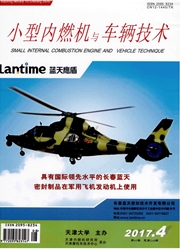

 中文摘要:
中文摘要:
汽油压燃低温燃烧是目前内燃机研究的一个热点。汽油压燃利用汽油高辛烷值、易挥发的燃料特性,在缸内形成相对均匀的预混合气,尽量使喷油和燃烧分离,同时获得低的NO_x、soot排放和高的热效率。对近年来汽油压燃的研究进展进行了回顾,并在此基础上对其发展趋势进行了展望。尽管汽油压燃表现出了较好前景,但其关键难题仍需要深入研究:一方面,大负荷汽油压燃低温燃烧是以高压力升高率为代价,同时仍存在碳烟排放问题,需要探索有效控制大负荷燃烧反应速率和碳烟排放的途径;另一方面,小负荷下汽油燃料燃烧效率低,未燃HC和CO排放高,燃烧稳定性差,对边界条件变化敏感,也是限制汽油压燃低温燃烧全工况运行的重要因素。
 英文摘要:
英文摘要:
Gasoline compression ignition of low temperature combustion is a hot topic in the research of internal combustion engine. Utilizing high-octane and volatile properties of gasoline, the relatively homogeneous premixed gas can be produced in the cylinder by gasoline compression ignition of low temperature combustion, so that the fuel injection phase and combustion phase are separated, which cause NOx and soot emission be overcome and higher thermal efficiency is obtained. In this paper, the research progress of gasoline compression ignition in recent years has been reviewed, and the development trend has been prospected on this basis. Despite the gasoline compression ignition has shown good potential, its key problems still need to be studied in depth: on the one hand, high-load gasoline compression ignition is at the expense of high pressure increase rate, while still exist smoke problem, need to explore effective control of large load combustion reaction rate and smoke emissions. On the other hand, the combustion efficiency of gasoline fuel under low-load is low, the unburned HC and CO emissions are high, combustion stability is poor, and the sensitive to boundary conditions is still limited. These problems are still an important factor limiting the operation conditions of gasoline compression ignition.
 同期刊论文项目
同期刊论文项目
 同项目期刊论文
同项目期刊论文
 期刊信息
期刊信息
